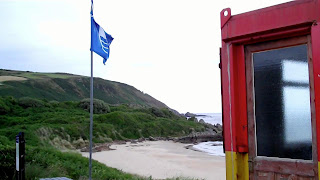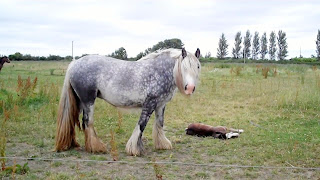This is from early October, 2010
Link Here
VideoDetroit
experiments with video and photography from a city in free fall
Sunday, November 28, 2010
Saturday, November 27, 2010
Wednesday, October 20, 2010
Mommasita and the Gang of 3
That's right! More stray cats planning a home invasion. They have established a beachhead on the back porch and the cute, brave one (Digger) has already conducted reconnaissance as deep as the middle of the kitchen. Most importantly, they have a high level collaborator. I have been meeting with the Gang of Four and the senior cats to plan a defense. They tell me they are willing to lay down their lives in defense of their home, but what's the point? To the last one, they have told me privately that KS is hopeless and we better get used to it. I always imagined that cats were romantics, not fatalists. Ah well, here are the new lot - fed, named, but not inside. Yet.
Tuesday, July 20, 2010
An amazing sight (by KS)
KS saw this amazing bird on the grounds across the street from the Detroit Institute of Art. I'm posting the pictures for her and she'll add comments later. (Warning: Not for pigeon lovers.)
Click to enlarge.
Click to enlarge.
Saturday, July 17, 2010
Tuesday, July 13, 2010
Donegal Lighthouse on a very windy day
A North Atlantic storm was funneling fierce winds across Western Ireland as we headed north to Buncrana. The winds stayed with us the whole time we were in the north.
Donegal Manor
We stayed at the Donegal Manor B & B when we first came to Donegal. It is located on N15 about a two kilometers outside of Donegal Town. The road behind the Manor led up a small hill and ended in an courtyard to a farm. The road was lined with wildflowers.

The suit of armor moved from the steps into the entranceway several times, yet I never saw anyone move it. It's a mystery.
We were told by one of our hostesses that, when she was a child, she was told Foxgloves were called Fairy Thimbles.

The suit of armor moved from the steps into the entranceway several times, yet I never saw anyone move it. It's a mystery.
We were told by one of our hostesses that, when she was a child, she was told Foxgloves were called Fairy Thimbles.
Irish Horses
These horses were in a field across the street from our hotel near the Dublin Airport.
KS: We could see the horses, 2 mares with foals, plus a stallion, from our hotel room. The Appaloosa-coated mare is lying beside her foal (not visible in the photo), born the day we arrived at the hotel. It was extremely tiny compared to the other foal.
When we went for a walk, I was surprised to see that these were draft horses - the grass had covered their big feet. They were very small, too, or rather, short, as they were very sturdy-looking beasts. Had to have been the shortest draft horses I've ever seen (not that draft horses are a fixture in my routine activities). The stallion was about my height from his ear to ground, and appeared less than 48inches (12 hands) tall.
Monday, July 12, 2010
The Lighthouse Dog, Donegal Coast
It took a while for us to understand each other as he was a Gaelic speaker.
Teach Phobail an Spainigh: The Spaniard's Church, outside Kilcar, Donegal
The story of the Spaniard's Church requires a Catholic author. There is too much mystery and overtones of the miraculous to come easily to a Protestants, especially a Scottish Presbyterian. Therefore I've decided to go straight to a Catholic source, Sacred Sites in the Parish of Kilcar, Co Donegal, Catherine Campbell, O.P., (self Published), copies available at Aislann Chill Chartha (The Kilcar community center .)
"Situated between Kilcar / Carrick road at a place call Bun na dTri Sruthán at the bottom of Gleann an Bhaile Dhuibh (now known as Cashlings) is an unusual long building. The story behind it is as fascinating today as it was two hundred and fifty years ago.
On a nice summer evening in 1756 a Spanish cruiser was observed around Glenhead making its way to Donegal Bay. The Glencolmcille folk were aware of a storm brewing and hastened indoors. The parish priest, with his faithful clerk, Denis or Owen, had been on a sick call in Mallinberg. The household pressed them to stay the night but the priest wouldn't hear of it. As the two crossed Sliabh Liag the wind rose up and they had to fight their way on.
The clerk pressed the priest to go back but to no avail. Fear gripped the poor pony. The priest insisted they go on, assuring the clerk 'the angels will guard us.' Halfway along the mountain they heard crying and moaning. The proest located wherefrom the sound was coming, and taking stock of the sea-cliff, carefully chose his route down, marking it along the way.
Down below, a fatally wounded soldier breathed a sigh of relief and disbelief as he saw a priest. That the priest could speak Spanish was a great comfort to the Spaniard. He asked forgiveness from God for his wasteful life, and told the priest of his habit of saying three Hail Marys for a happy death. He showed his deep gratitude to the priest by offering his belt filled with gold coins, only minutes later breathing his last.
To the great relief of the clerk, the priest eventually arrive back up the mountain.
The pair continued their journey along the 'One Man's Path.'
A version of his story also exists where a woman brought the news of the dying Spaniard, but afterward disappeared. There is yet another very detailed version printed by 'Kinnfaela.' The parish priest, who could have been Fr Owen Carr, Fr Kerr, or Fr Cannon, had a church with a thatch roof built at Cashlings, and he also had the old church at Faugher, Glencolmcille rebuilt.
We know that Teach Phobail an Spainigh served the local community well until 1830, when the new church in town was dedicated. '
KS's family lived in this part of Donegal and, perhaps they attended this church.
Note: the Church was rebuilt in 1985 and the original stones were put in the foundation (Campbell, p. 12). The thatched roof has collapsed, but the walls remain solid.
The Presbyterian version would involved many committee meetings, conflicts over the purchase price of the land, and a fierce debate over the questions of windows on the north face. (The no windows side won, their arguments about winter storms carrying the day against those who argued for God's symmetry.) There would be benches and boxes, with the wealthy families buying the boxes at the front, closer to God.
This is the best I could do to capture the stones placed near the roofline at right angles to the wall. The thatch roof was overlaid with ropes that were tied to these protruding stones to anchor the roof.
This is the best I could do to capture the stones placed near the roofline at right angles to the wall. The thatch roof was overlaid with ropes that were tied to these protruding stones to anchor the roof.
The windowless north wall
of the Spaniard's Church.
A travel confession: KS and I had a hell of a time finding this place. KS had a map which usually is all she needs. I was very tired and concentrating on staying on the left side of narrow country roads and shifting with my left hand. When we first found the church, I said, "That's some old agricultural building. That can't be it." We returned three more times (damn map) before we investigated the "agricultural building" and I had to admit I was wrong. KS generously didn't mention my earlier archeological error.
Subscribe to:
Posts (Atom)






















































